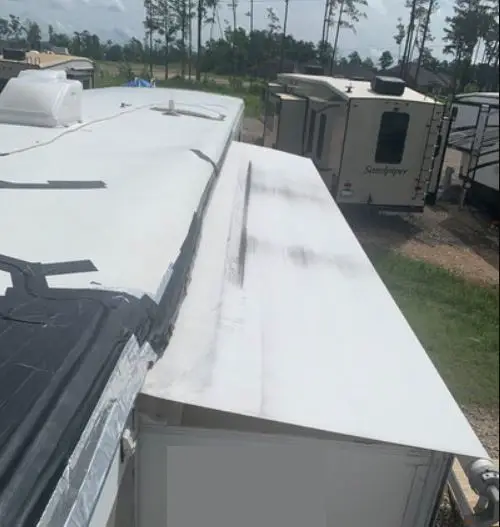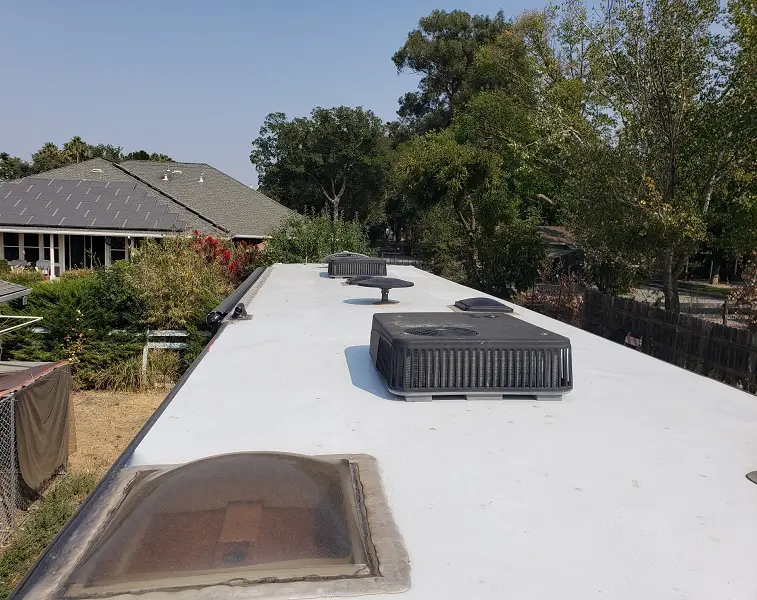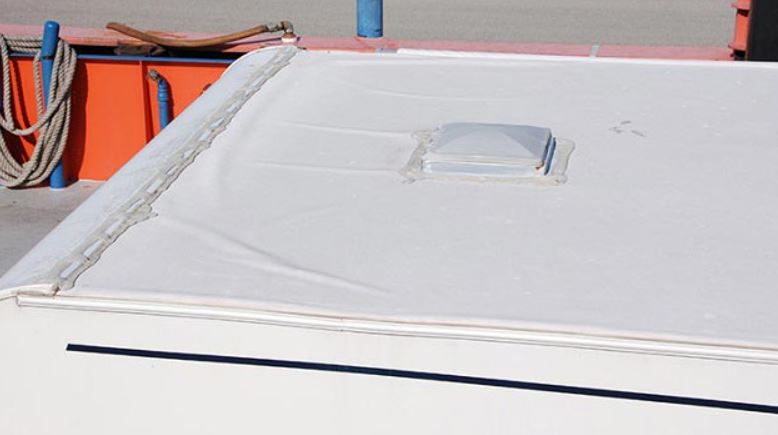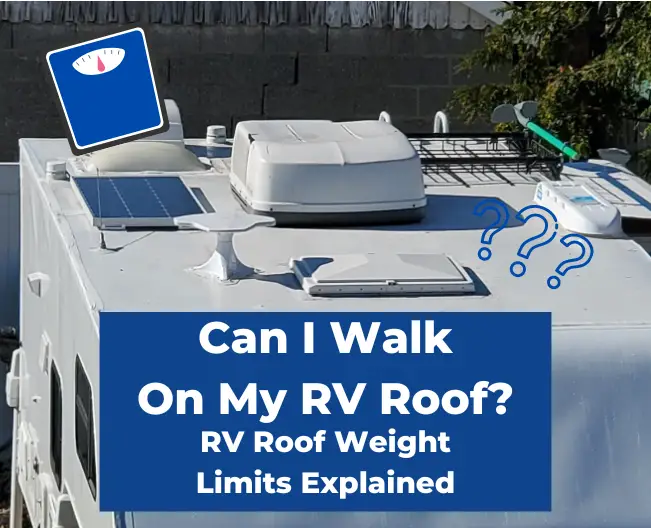RVs are a popular mode of transportation for many people who enjoy traveling and exploring the great outdoors. While RVs offer a comfortable and convenient way to travel, it’s essential to know the weight limit of the RV roof to avoid any accidents or damage. The weight limit of an RV roof varies depending on the model, year, and condition. So how much weight can an RV roof hold?
Generally, most RV roofs can support up to 250 pounds. The weight limit of your RV’s roof can vary depending on the type of roof material, the design of the RV, and the weight distribution.
It’s also important to note that the weight limit of an RV roof is not just for walking on it. It includes the weight of any equipment, such as air conditioning units, solar panels, or satellite dishes, that are mounted on the roof. Exceeding the weight limit can lead to structural damage, leaks, and other issues that can affect the overall safety and functionality of the RV.
Understanding RV Roof Weight Limits

Types of RV Roofs
RV roofs come in different types, and the weight limit for each type of roof can vary. The most common types of RV roofs are:
- Fiberglass
- Rubber
- Aluminum
Fiberglass roofs are lightweight and durable, and they can typically hold up to 250 pounds. Rubber roofs are also lightweight and can hold up to 200-250 pounds. Aluminum roofs are heavier and can hold more weight, usually up to 300 pounds.
Factors that Affect RV Roof Weight Limits
The weight limit for an RV roof is not just determined by the type of roof, but also by several other factors. Some of these factors include:
- The age and condition of the roof
- The size of the RV
- The weight distribution of the RV
- The presence of any rooftop accessories, such as air conditioning units or solar panels
It is important to note that knowing how much weight an RV roof can hold is not an exact science, and it can vary depending on these and other factors. As a general rule of thumb, it is recommended to assume that the upper limit for most RV roofs is around 250 pounds and to take precautions from there. In summary, understanding the weight limit of an RV roof is crucial to ensure the safety of both the occupants and the RV itself. By knowing the type of roof and the factors that affect weight limits, RV owners can take the necessary precautions to prevent damage to their RV and avoid any accidents.
How to Calculate RV Roof Weight Capacity

Before stepping onto an RV roof, it’s important to know the weight capacity to avoid any damage or accidents. Here are some steps to help calculate the RV roof weight capacity:
Check Your Owner’s Manual
The first step is to check the owner’s manual for the RV weight capacity. The manual will provide information on the maximum weight the roof can hold, taking into account the type of RV and roof material. If the manual is not available, contact the manufacturer for more information.
Do You Have A Roof Ladder?
If the RV has a roof ladder, it’s a good indication that the roof is designed to be walked on. However, it’s important to check the weight limit stamped on the ladder. As a general rule of thumb, if the RV has a ladder, the roof should be able to support at least 250-280 pounds.
RV Roof Weight Ratings
RV roofs can typically hold 200-300 pounds, but it can vary depending on the roof material and the type of RV. For example, Class A RVs can hold up to 10,000 pounds, Class B RVs can hold up to 5,000 pounds, and Class C RVs can hold up to 8,000 pounds. It’s important to note that these weight ratings are for the entire RV, not just the roof.
Calculating Weight Distribution
When calculating weight distribution on the RV roof, it’s important to evenly distribute the weight. Avoid putting too much weight in one area, as this can cause damage to the roof. Use a weight distribution system to ensure that the weight is evenly distributed across the RV.
By following these steps, RV owners can ensure that they are not putting too much weight on the roof and avoid any potential damage or accidents.
Why Do You Need To Walk On Your RV Roof Anyway?

There are several reasons why you may need to walk on your RV roof. Some of the most common reasons include:
RV Roof Inspection
Regularly inspecting your RV roof is essential to ensure its longevity. Walking on your RV roof is necessary to perform a thorough inspection. You will need to check for any damage, cracks, or leaks. Inspecting your RV roof can help you detect any issues early on and prevent costly repairs.
Cleaning Your Roof
Cleaning your RV roof is also essential to maintain its longevity. You will need to remove any debris, dirt, or grime that may accumulate on your RV roof. Walking on your RV roof is necessary to clean it properly. However, you should take safety measures to prevent a fall.
Maintenance And Repairs
Performing regular maintenance and repairs is necessary to keep your RV roof in good condition. Walking on your RV roof is necessary to perform maintenance and repairs. You may need to reapply a new layer of sealant or fix any damage that may occur due to weather or other factors.
Cleaning Your RV Solar Panels
If you have RV solar panels, you may need to clean them regularly to ensure optimal performance. Walking on your RV roof is necessary to clean your solar panels properly. However, you should take safety measures to prevent a fall.
Tips For Walking On Your RV Roof Without Damaging It
Mind The Total Weight Of Your Tools
When walking on your RV roof, it is essential to be mindful of the total weight of the tools and equipment that you are carrying. The total weight should not exceed the weight limit of your RV roof. Most RVs can support up to 250-pounds. However, this is a distributed weight, and it includes the weight of the person, tools, and equipment.
Don’t Walk Near Vents
It is important to avoid walking near vents when you are on your RV roof. The vents are not designed to support the weight of a person, and walking on them can cause serious damage to your RV roof. If you need to work near the vents, use a ladder or crawl on your hands and knees.
Avoid The RV Roof Edges
Walking near the edges of your RV roof can be dangerous. It is easy to lose your balance and fall off the roof. Therefore, it is essential to avoid walking near the edges of your RV roof.
Crawling Is Better Than Walking
Crawling on your hands and knees is safer than walking on your RV roof. This method distributes your weight more evenly, reducing the risk of damage to your RV roof. It also provides better stability and control.
Only Walk On Your RV Roof In Dry Conditions
Walking on your RV roof when it is wet can be dangerous. Wet surfaces are slippery and can cause you to lose your balance. Therefore, it is essential to only walk on your RV roof in dry conditions.
Only Walk Forward, Not Backwards
When walking on your RV roof, it is important to only walk forward, not backward. Walking backward can be dangerous, as it is easy to lose your balance and fall off the roof. Therefore, always walk forward when you are on your RV roof.
Tips for Protecting Your RV Roof
Avoiding Overloading Your RV Roof
It is important to know how much weight can an RV roof hold to avoid overloading it. RV roofs can support 220 to 250 pounds on average. It’s always best to check the ladder or owner’s manual for the weight limit rating.
When walking on the roof, it is important to walk slowly and feel for soft spots. You should perform any RV roof repairs for soft spots as needed. If you have an older roof or a roof in poor condition, go slow and use your weight to feel for soft spots before stepping with your full body weight.
It is also recommended to use the RV’s roof ladder to climb onto the roof, as this is the most secure method to access the roof.
Regular Maintenance and Inspection
Regular maintenance and inspection can help protect your RV roof and extend its lifespan. You should inspect the roof at least twice a year for any signs of damage or wear and tear.
It is also recommended to clean the roof regularly to prevent debris and dirt from accumulating. Use a soft-bristled brush and mild soap to clean the roof. Avoid using harsh chemicals or abrasive materials that can damage the roof.
Finally, it is important to repair any damage as soon as possible to prevent further damage from occurring. Small cracks or holes can be repaired with a sealant, while larger damage may require professional repair including a full RV roof reseal.

